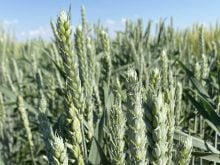GRAPEVINE, Texas – A drought threatening the winter wheat crop in Texas and Oklahoma is spreading into the United States’ top wheat producing state, Kansas.
“There is a lot of worry by producers in the southern part of the state as far as how dry it is getting,” said Greg Akagi, president-elect of the Kansas Agriculture Network.
Specifically, southwestern Kansas is bone dry as the wheat crop emerges from dormancy.
The rest of the state is becoming parched as well, with most producers reporting less than 25 millimetres of winter rainfall. Perhaps even more worrisome is the lack of snow cover.
Read Also

Grain farming’s hard times expected to continue
Rabobank says it will be two more years before North American grain farmers achieve break-even due to “monster” supplies and “sticky” crop input prices.
“Any producer would tell you what they’d love to have is about six inches of snow during dormancy to cover the crop and to get that moisture to settle in. And they haven’t had it, have not had it at all. Maybe an inch or two at the most,” Akagi said.
U.S. Wheat Associates reports 59 percent of the winter wheat crop is rated good to excellent in Kansas compared to 42 percent a year ago.
However, that data stems from a Feb. 2 U.S. Department of Agriculture report. There is a lot less moisture around today. Akagi said conditions are not as dire as they have been in previous drought years, but it is certainly less than ideal and cause for concern.
Texas is by far the worst off. The USDA reports 58 percent of the winter wheat crop in that state was rated poor to very poor as of Feb. 22.
David Cleavinger, president of the National Association of Wheat Growers, farms in Wildorado in northern Texas, where conditions are unusually harsh.
“I’m up in the Hereford-Amarillo area and we’re seeing higher than normal temperatures and we haven’t had rain since October,” he said.
The next two weeks are critical for the wheat crop in that state.
“We’re hoping that we will kind of see some moderation in these temperatures where we can get a little cooler. We would love to see a rain, or some snow would be great.”
John Oades, vice-president of U.S. Wheat Associates, said it is not out of the ordinary to have dry conditions in Oklahoma, Texas and southwestern Kansas at this time of the year.
“That area has routinely been dry and certainly is again this year.”
The remainder of the U.S. hard red wheat crop is generally in good shape, as is the soft white crop.
“(Winter wheat) is not terrible by any means. It’s reasonably decent with the exception of those drought areas.”
However, acreage is down considerably. Growers planted 42.1 million acres of hard red winter, soft red winter and white winter wheat in the fall of 2008, down nine percent from the 46.3 million acres seeded the previous year.
Spring wheat acreage is anybody’s guess, Oades said. “I hear a great diversity of opinion about that.”
Some state associations predict a big decrease while others say there will be no significant change from last year’s acreage.
However, Oades is certain wheat producers in the Red River Valley and other high rainfall areas of the northern tier states will consult their soybean, corn and wheat budgets right until seeding time. He thinks those budgets now point them in a direction other than wheat.
“I don’t anticipate increases in (wheat) plantings in the Red River Valley or the higher rainfall areas. In fact, if I were to guess, and it would be purely a guess, probably some decrease there.”
Another reason for his pessimism about spring wheat acreage in that region is that while the southern states have been dry, the northern states are excessively wet.
“Much of that country has a lot of snow on it yet. The later you get in the planting window the more that favours soybeans or corn over wheat,” he said.
But anything can happen in the next 60 days, so he’s not willing to pass any judgment on spring wheat acreage just yet.















